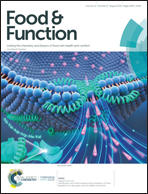Liquid state fermentation vinegar enriched with catechin as an antiglycative food product
Abstract
Catechin, a natural antiglycative agent, was incorporated into fermented vinegar, and has high potential to lower the risk of diabetes. In this study, vinegar containing 5% catechin as a substrate for acetous fermentation significantly inhibited the formation of total fluorescent advanced glycation end-products (AGEs), as well as Nε-(carboxymethyl)lysine (CML)/Nε-(carboxyethyl)lysine (CEL), especially when added during acetic fermentation. Further study proved that catechin could not only significantly suppress the increase of blood glucose levels, but also inhibit α-amylase, α-glucosidase and β-glucosidase strongly with IC50 values of 0.533 mg mL−1, 0.307 mg mL−1 and 0.413 mg mL−1, respectively. Moreover, 32 volatile compounds were finally identified by headspace solid phase microextraction gas chromatography-mass spectrometry (HSPM-GC-MS) and electronic nose. The flavor of the catechin–vinegars, which possess relatively high ester and low acid contents, was superior to that of traditional vinegar. Therefore, it was helpful to use catechin as a functional food ingredient in vinegar to prevent AGE-associated diseases and alleviate postprandial hyperglycemia, through limiting the digestion of starch and inhibiting the uptake of glucose. Meanwhile, the pleasant flavor and safety of catechin–vinegar were better than traditional vinegar, which represents prominent value to attract consumers.



 Please wait while we load your content...
Please wait while we load your content...